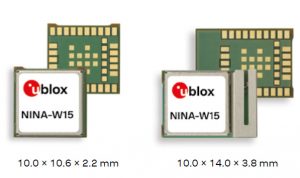[ad_1]
Called NINA-W152, it measures 10 x 14 x 3.8mm including its built-in antenna. If an external antenna is needed, the 10 x 10.6 x 2.2mm NINA-W151 has a pin through which to drive one.
“The NINA-W15 modules support simultaneous operation on Wi-Fi and Bluetooth dual-mode and can thus serve as a gateway between Bluetooth and Wi-Fi or Ethernet. They can act as both Wi-Fi station and micro access point and connect to a host system using either a UART or a high speed RMII interface,” said the firm. “The modules will be particularly useful in products such as hubs that need to connect local Bluetooth and/or Wi-Fi peripherals to a wider-area network.”
Security features include WPA/WPA2, enterprise security (EAP-TLS, PEAP), secure boot and secure simple pairing.
Power comes from 3.0 – 3.6V, and consumption is 140mA with Wi-Fi (15dBm), 147mA for Bluetooth (BR/EDR 6dBm), 57mA for Bluetooth LE (6dBm) and 36mA idling.
Applications are foreseen in industrial automation (machine control, industrial terminal and remote control), building automation, smart building/home equipment (HVAC and lighting), retail point-of-sale terminals, telematics control and medical equipment (defibrillators and urology monitors).
“Several industries are focusing on digitalisation, and a common scenario is to connect a huge number of sensors and actuators to a back-end system or to cloud service, for analysis and visualisation or even controlling applications,” says U-blox marketing manager Stefan Berggren.
Initial production is planned for the first quarter of next year, and there will be an evaluation kit.
Modules will be supplied pre-flashed with U-blox connectivity software. “This supports several connectivity use cases, such as multiple individually controlled connections, simultaneous GATT protocol and serial port service, and simultaneous peripheral and central role,” said the firm. “These features can be accessed by a host microcontroller by using simple AT commands to configure and control the modules, and to control communications with external Bluetooth and Wi-Fi devices.”
[ad_2]
Source link

